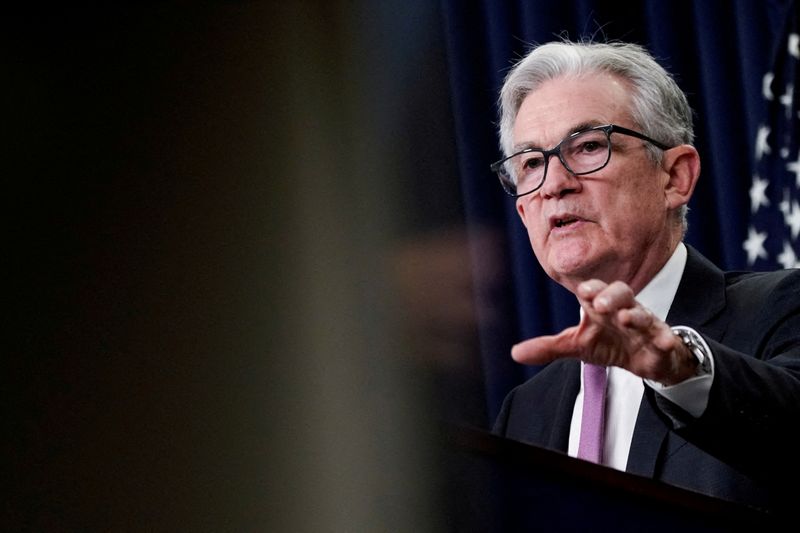By Gertrude Chavez-Dreyfuss
NEW YORK (Reuters) - Investors are bracing for the Federal Reserve to double down on its commitment to crushing inflation, and expect its chair Jerome Powell at the annual central bank gathering in Wyoming this week to deliver an aggressive tightening message and dash hopes for a rate cut next year.
The Jackson Hole, Wyoming retreat comes after investors last week viewed the transcripts from the Fed's July meeting as leaning dovish and as a green light to put some risk back on the table. The stock market initially held up and bond yields were steady, before markets re-considered that interpretation.
Since the release of the Fed minutes on Aug. 17, the S&P 500 has fallen roughly 3.8%, the benchmark 10-year Treasury yield has risen about 10 basis points (bps) and nudged back above 3%, and the dollar gained around 1.7% against the yen, the currency pair most sensitive to rate expectations.
Powell's Friday morning speech could cement the market tone until the next Federal Open Market Committee meeting next month.
"Caution and fear are the theme for the markets," said Steven Englander, head of global G10 FX research and North America macro strategy at Standard Chartered (LON:STAN) in New York.
"If Powell says something hawkish and if you buy equities or emerging market currencies, you'll lose 3% before you can blink your eye. So nobody is buying risk right now in the run-up to Jackson Hole."
The Fed, in the July meeting minutes, said it saw "little evidence" that inflation pressures have eased, but recognized the risk it might tighten too much and curb economic activity.
Fed funds futures have priced in a 51% chance of a 50 basis-point (bp) rate hike next month, with the fed funds rate hitting 3.6% by the end of the year. A week before Wednesday's release of the minutes, the rate futures market had factored in a 75-bps rate increase.
Eurodollar futures have priced in at least one rate cut between March and December 2023, with the spread between the two contracts at roughly -44 bps on Monday. The peak fed funds rate is seen at 3.9% in March, eurodollar futures showed.
Harley Bassman, managing partner at Simplify Asset Management in Laguna Beach, California, thinks the rate futures pricing is way off.
"I think the Fed goes more than what the market thinks in terms of rate hikes. I don't think inflation is going to be at 2%-3% next year. It's baked in the cake," said Bassman.
A drop in fuel costs left U.S. consumer prices unchanged in July, bolstering a moderating inflation scenario, although underlying price pressures remained elevated. Producer prices also declined last month on the back of cheaper energy.
Graphic: US inflation measures https://fingfx.thomsonreuters.com/gfx/mkt/klpykwrazpg/US%20annual%20inflation.PNG
"Basically we have seen house prices go 10-20% higher," said Bassman. "And you're going to see OER (ownerS' equivalent rent) keep on rising for the next six to nine months. So the actual CPI print that goes to newspapers is going to keep rising over the next 12 months."
Perhaps complicating Powell's messaging, second quarter U.S. core personal consumption expenditures price data, an important inflation gauge for the Fed, is due out an hour and a half before the Fed chief's speech starting at 10:00 a.m. EDT/1400 GMT.
Still the bond market is pricing in a less dire inflation picture. One gauge, breakeven inflation, which measures the difference between the yield on U.S. Treasury Inflation-Protected Securities (TIPS) and nominal Treasuries, has declined since mid-June from one-year out to 30-year maturities, Refinitiv data showed.
LESS FRONT-LOADING OF RATE HIKES?
Standard Chartered's Englander believes the Fed will do whatever it takes to pull inflation down to its 2% target, but it won't do all the hikes in the next few meetings.
"They could say something like: we will hike for as long as we have to, as high as we have to, but we don't have to do it over the next two to three meetings," Englander said.
Ahead of Jackson Hole, speculators' net long positioning on the safe-haven dollar rose for the first time in four weeks, according to calculations by Reuters and U.S. Commodity Futures Trading Commission data released last Friday. [IMM/FX]
Graphic: US dollar net longs https://fingfx.thomsonreuters.com/gfx/mkt/zjpqkblrypx/U.S.%20dollar%20net%20longs.PNG
"The market is panicking up as we approach Jackson Hole," Englander said.
To be sure, there are market participants who believe there is scope for the Fed to reduce its tightening pace because the U.S. economy is slowing down.
The Fed though might not say so in Jackson Hole.
Jeffrey Roach, chief economist at LPL Financial in Charlotte, North Carolina, cited a mid-1990s tightening cycle, in which the U.S. labor market weakened. The Fed responded by holding rates steady, while it monitored the economy.
"There is still a chance for the Fed to stick a soft landing here," Roach said.

A soft landing for the U.S. economy though is not the base-case scenario for Simplify's Bassman, and recession is certainly on the horizon.
"So you want to buy fire insurance. I am crazy bearish on rates. I do see reasonable scenarios of rates -- be it the 10-year note or the fed funds rate -- going to 4% or higher."